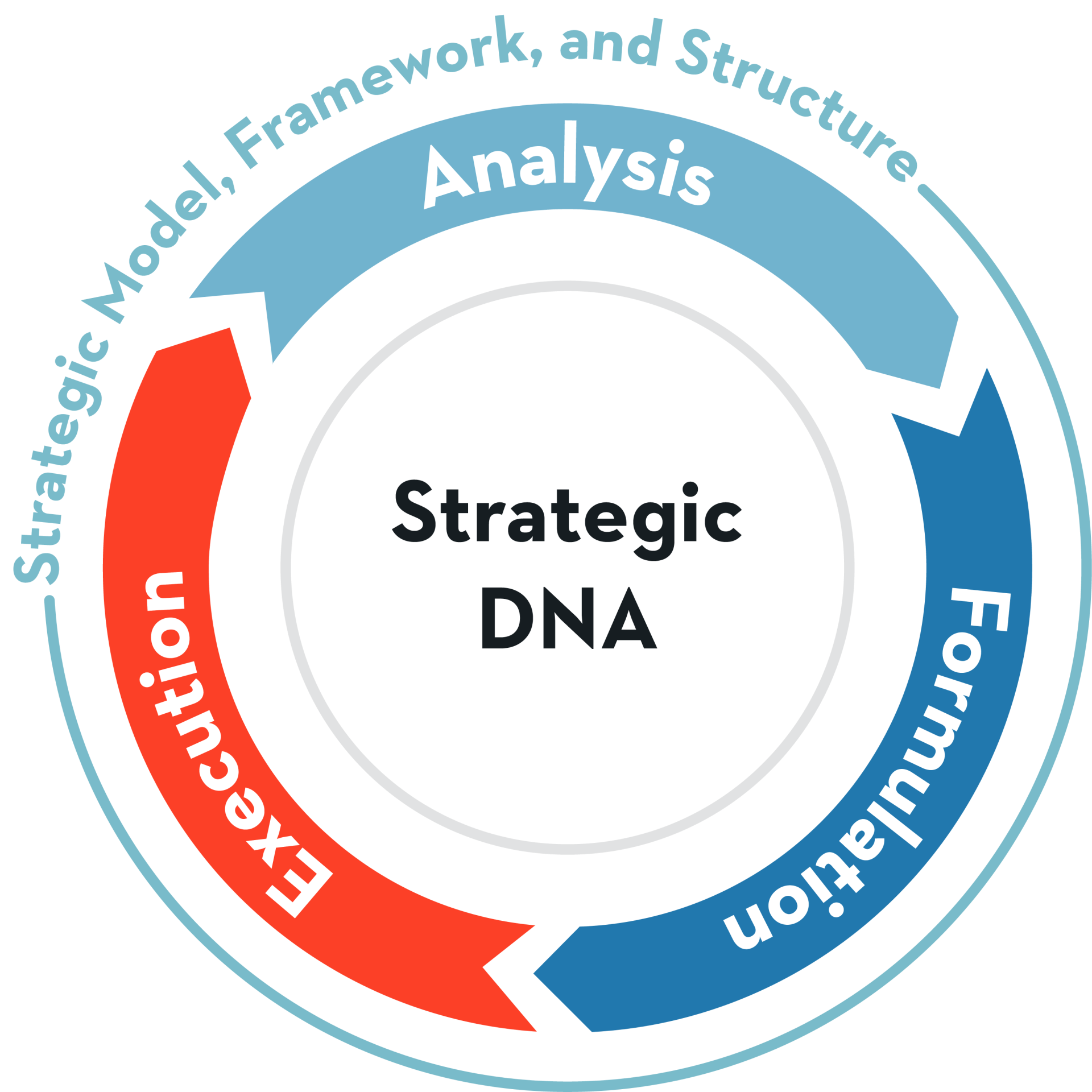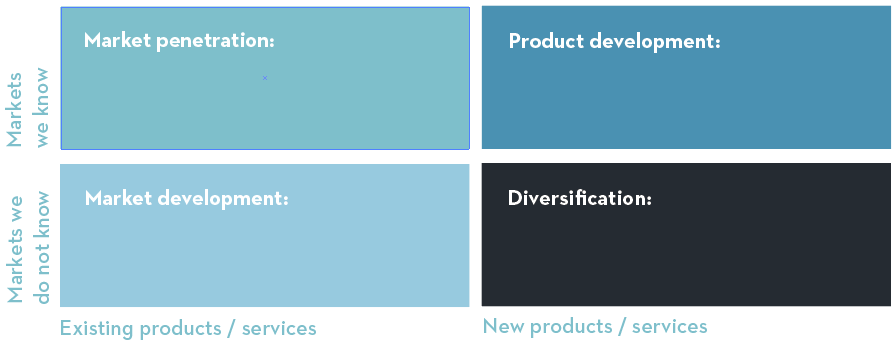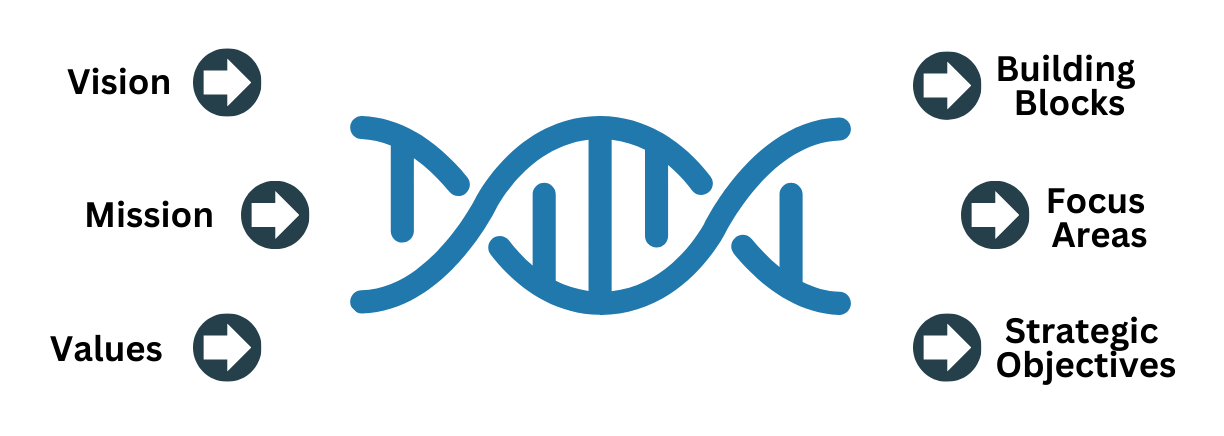Ray Fletcher
5 Steps to Design and Implement a Successful Strategy
Strategic planning is not a linear process, nor is there a single correct approach to its formulation. We present a five-step strategic model that any business can implement to navigate the nuances and complexities inherent in strategic planning.
Organizations have distinct visions, target markets, and value propositions, which necessitate tailor-made solutions. The PurposeLab Model acknowledges this reality and aims to simplify the planning process by providing a step-by-step guide for creating customized strategic plans.
Innovation and Creativity at the Core
This model goes beyond best practices in strategic management; it emphasizes the importance of integrating creative methodologies such as Design Thinking and creative leadership to develop innovative strategies that transform business models.
In this blog, you'll discover how the PurposeLab Model combines strategic management best practices with creative methodologies. When applied in a structured manner, this approach yields strategies uniquely tailored to each organization.
The model comprises five key stages: Defining Foundations, Defining Strategic DNA, Analysis, Formulation, and Execution. Let's delve into each stage to understand how they collectively facilitate effective strategic planning.

Step 1: Defining Foundations
Before considering strategic objectives, initiatives, and projects, it's critical we lay the right foundation. Like the entire strategic planning process, foundations differ from company to company. In this fist step of the planning process, the focus is on building the outer circle of the strategy which includes:
+ Defining the organizational structure
+ Selecting a Strategic Model
+ Choosing the right Strategic Framework(s)
Define the Organizational Structure
Oftentimes, organizations overlook the critical step of assessing their organizational structure and although it may seem obvious, it's important to consider how the strategy will cascade through the organizational levels and it starts by defining how many levels your organization has, this will dictate who will be affected by the strategy and how each of the levels will contribute.
Select a Strategic Model
Strategic models give your strategy structure. They define the elements of its structure and the interactions within those elements. They are also important in determining revision cycles, choosing a strategic model for your organization requires leaders to define the speed of their strategies deployment as well as the terminology of its structure. This helps align the organization to a common language.
The fundamental elements common to all strategic frameworks include the organization's vision, focus areas, strategic objectives, projects or initiatives, and key performance indicators. There are 3 strategic models we recommend using, Hoshin Kanri, Objectives and Key results (OKRs), and the PurposeLab Flexible Model which can be used by organizations who want to blend the previous two.
Choose the Right Strategic Framework
Strategic frameworks aren’t necessary to the planning process but they certainly help in facilitating the process. They are used to determine the focus areas of a strategic plan. Strategic frameworks help formulate specific focuses. They serve as thought exercises where the end goal is to determine what the strategy will focus on whether its growth, diversification, market penetration, product leadership, etc..
We present 4 frameworks that have been carefully chosen to serve different organizational needs. They are, Balanced Scorecard, Value Disciplines, McKinsey 3 Horizons, and Ansoff's Matrix. To read more about these frameworks and their approaches, read our blog on Strategic Frameworks here.
Strategic Models vs. Strategic Frameworks
You will often find different definitions for these two terms depending on the source. At Purpose Lab, both have distinct characteristics in strategy formulation. We describe models as structures for your strategy. Think of models as blueprints for a home, defining where the kitchen, bedrooms, and restrooms go. In this context, they define where your focus areas are and how they relate to initiatives, projects, and KPIs.
Frameworks, on the other hand, are tools used to enhance the planning process. They provide a way of thinking and analyzing situations, guiding strategic discussions through specific guidelines. For example, one framework we are particularly fond of is the Ansoff Matrix. This framework helps guide organizations in thinking about growth strategies in four distinct ways: market penetration, product development, market development, or diversification. Using a framework can streamline the planning process within your teams.
Example of Ansoff’s Matrix

Step 2: Defining Your Strategic DNA
In step 2 of our framework, you will define your organization's vision, mission, and strategic objectives. We break this section into two parts: The Philosophy and Building the Future.
The Philosophy
If you are here, you are probably familiar with the terms purpose, vision, and mission. However, these terms are often misused. These elements are essential in our strategic planning process as they help us understand foundational aspects like why we do what we do, why our organization exists, where we want to go, and what we will do to achieve our goals.
Building the Future
Building the Future builds on the first part of this step by expanding on the terms discussed above. This step is immersive and must be done with a team. It involves a series of collaborative sessions where the team engages in discussions about the company's future. These sessions are guided by helpful exercises, and by the end, the team should have a clear understanding of the milestones necessary to achieve the organization's vision. These milestones are broken down into focus areas, which become the backbone of our strategy and allow the team to generate strategic objectives.

Unlock the rest by downloading our Framework Guide
Download our free Framework Guide to discover our 5-step approach to designing and implementing innovative strategies. By signing up, you'll receive a comprehensive guide with an in-depth overview of our Framework. Kickstart your strategic journey and start applying essential principles and techniques today!
Thank you!
Latest from our blog
Who we are
Lorem ipsum dolor sit amet, mea id vidit feugait. Stet periculis mei in. Vis modus debitis te, ad usu duis fierent praesent.
Popular courses
-
Course 1
-
Course 2
-
Course 3
-
Course 4
Get in touch
-
Facebook
-
Twitter
-
Youtube
Copyright © 2024

